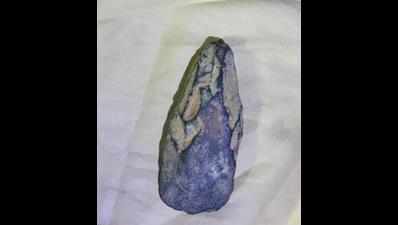- News
- City News
- vijayawada News
- Neolithic tool surfaces at Somasila
Trending
This story is from December 28, 2020
Neolithic tool surfaces at Somasila

Tool dated to 4,000 to 2,000 BCE
Vijayawada: A Neolithic celt made out of solarising stone was discovered at Somasila village under Kollapur mandal in Nagarkurnool district in Telangana by Dr E Sivanagireddy, archaeologist and CEO, Cultural Centre of Vijayawada and Amaravati.
Dr Reddy spotted the Neolithic tool while on a survey of archaeological remains in and around Somasila village, located on the left bank of the Krishna river.The celt measures 4x2x1 inches and has very sharp edges that have been arrived at after grinding and polishing.
The celt is coated with a patina of lime and ash denoting that it was dumped in a pit after use. Based on similar evidence found at a nearby village, Chinnamarur, in which a Neolithic habitation was excavated by the former state department of archaeology and museums in the early 1980s, Dr Sivanagireddy dated the stone tool at Somasila to the period between 4,000 to 2,000 BCE during which domestication of animals, intensification of agriculture and settlements at one place began.
The find was noticed in the agricultural field of Telugu Pentaiah of the same village from which Neolithic tools such as discoids, pestles and grinding stones were recovered two decades ago.
Dr Reddy spotted the Neolithic tool while on a survey of archaeological remains in and around Somasila village, located on the left bank of the Krishna river.The celt measures 4x2x1 inches and has very sharp edges that have been arrived at after grinding and polishing.
The celt is coated with a patina of lime and ash denoting that it was dumped in a pit after use. Based on similar evidence found at a nearby village, Chinnamarur, in which a Neolithic habitation was excavated by the former state department of archaeology and museums in the early 1980s, Dr Sivanagireddy dated the stone tool at Somasila to the period between 4,000 to 2,000 BCE during which domestication of animals, intensification of agriculture and settlements at one place began.
The find was noticed in the agricultural field of Telugu Pentaiah of the same village from which Neolithic tools such as discoids, pestles and grinding stones were recovered two decades ago.
End of Article
FOLLOW US ON SOCIAL MEDIA











